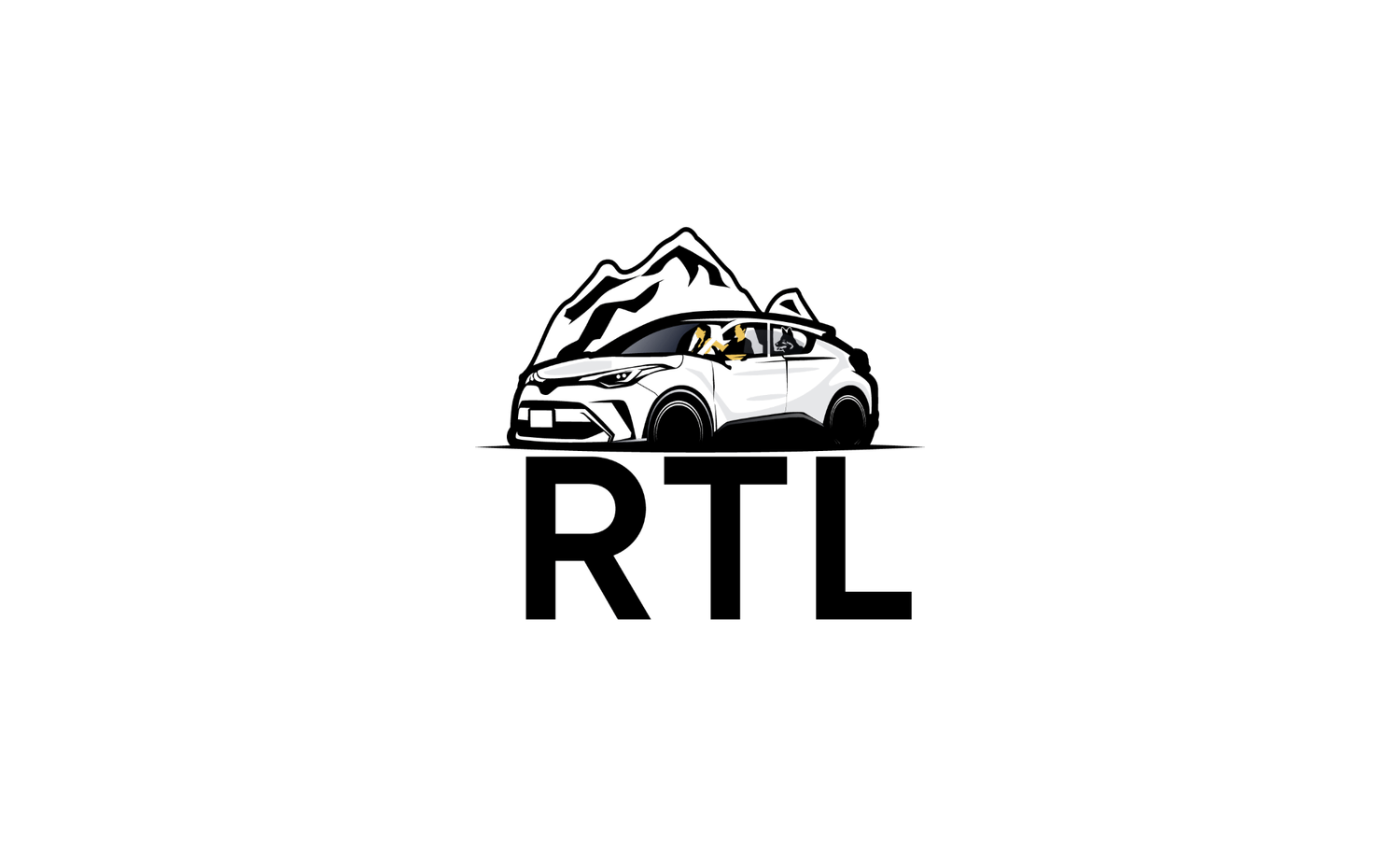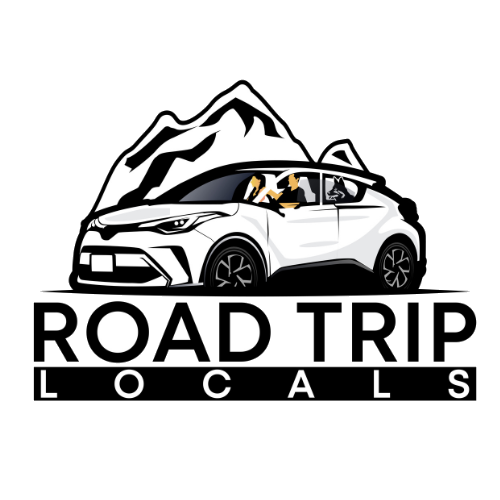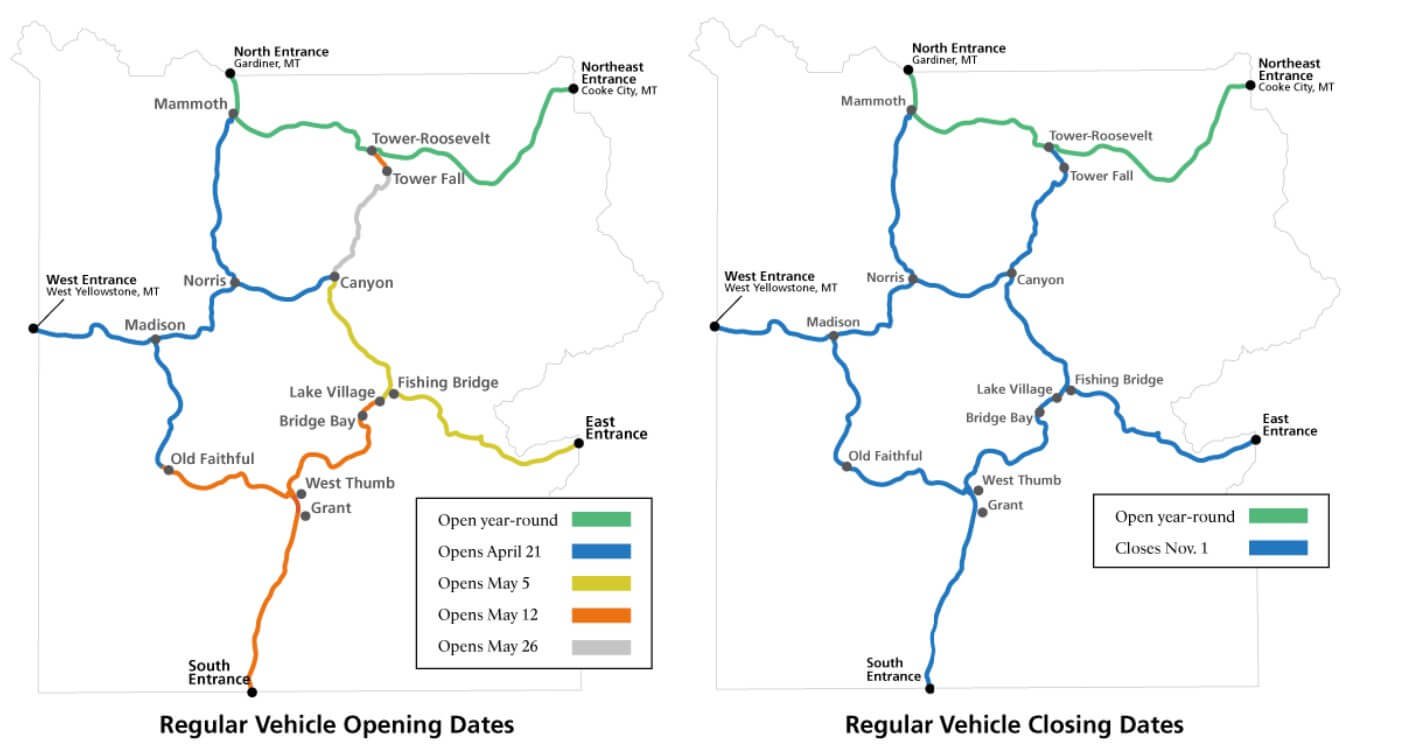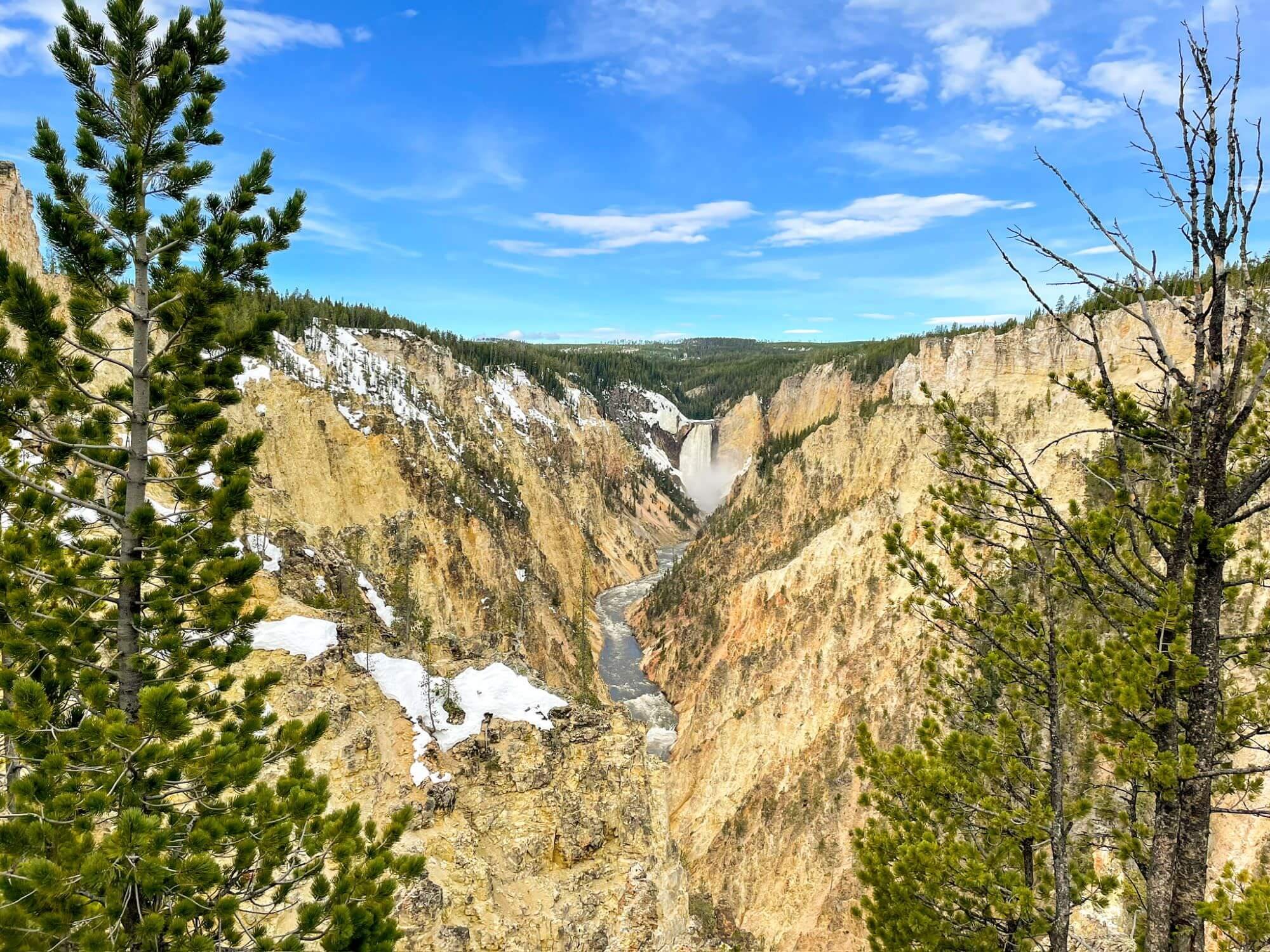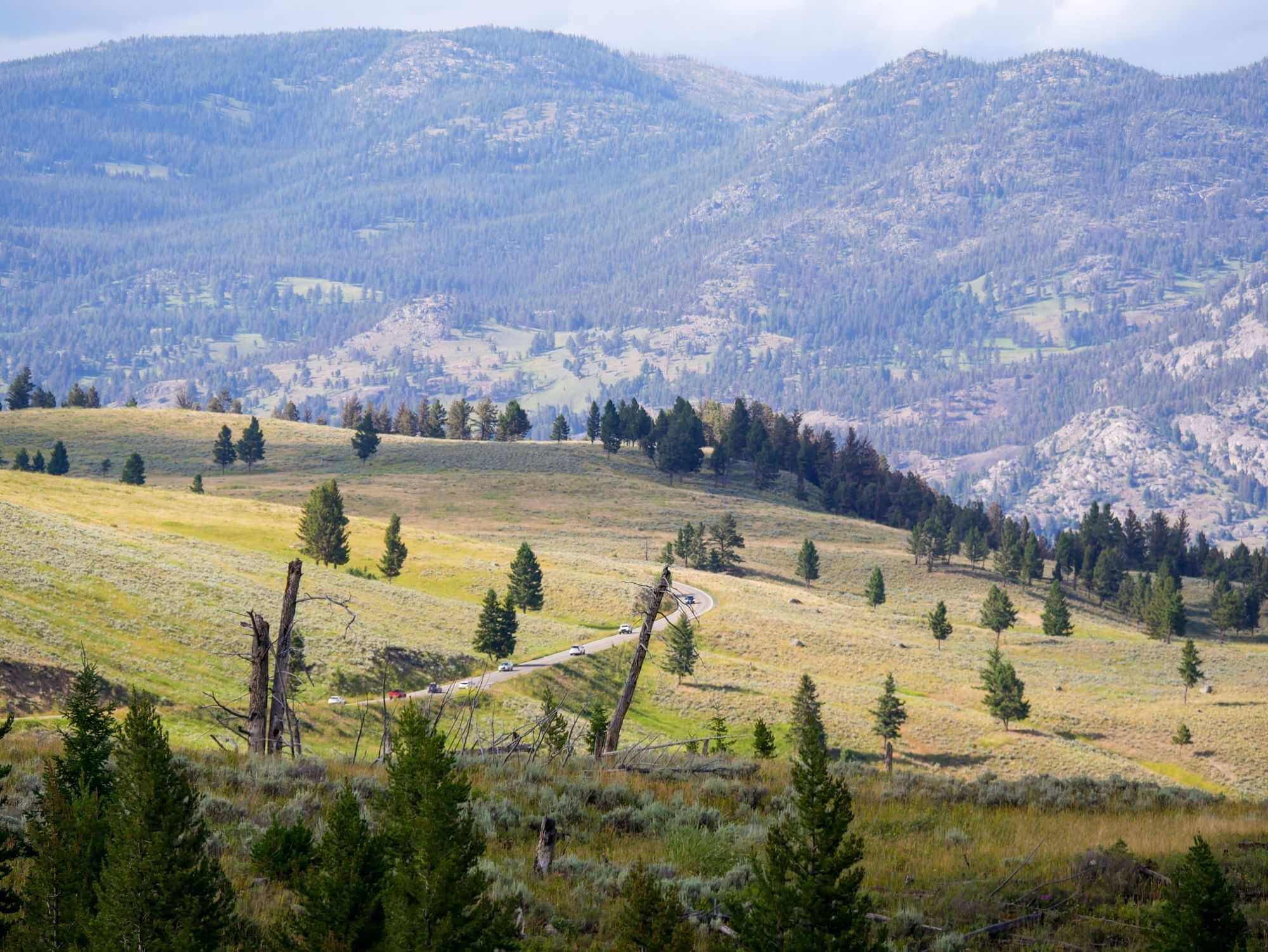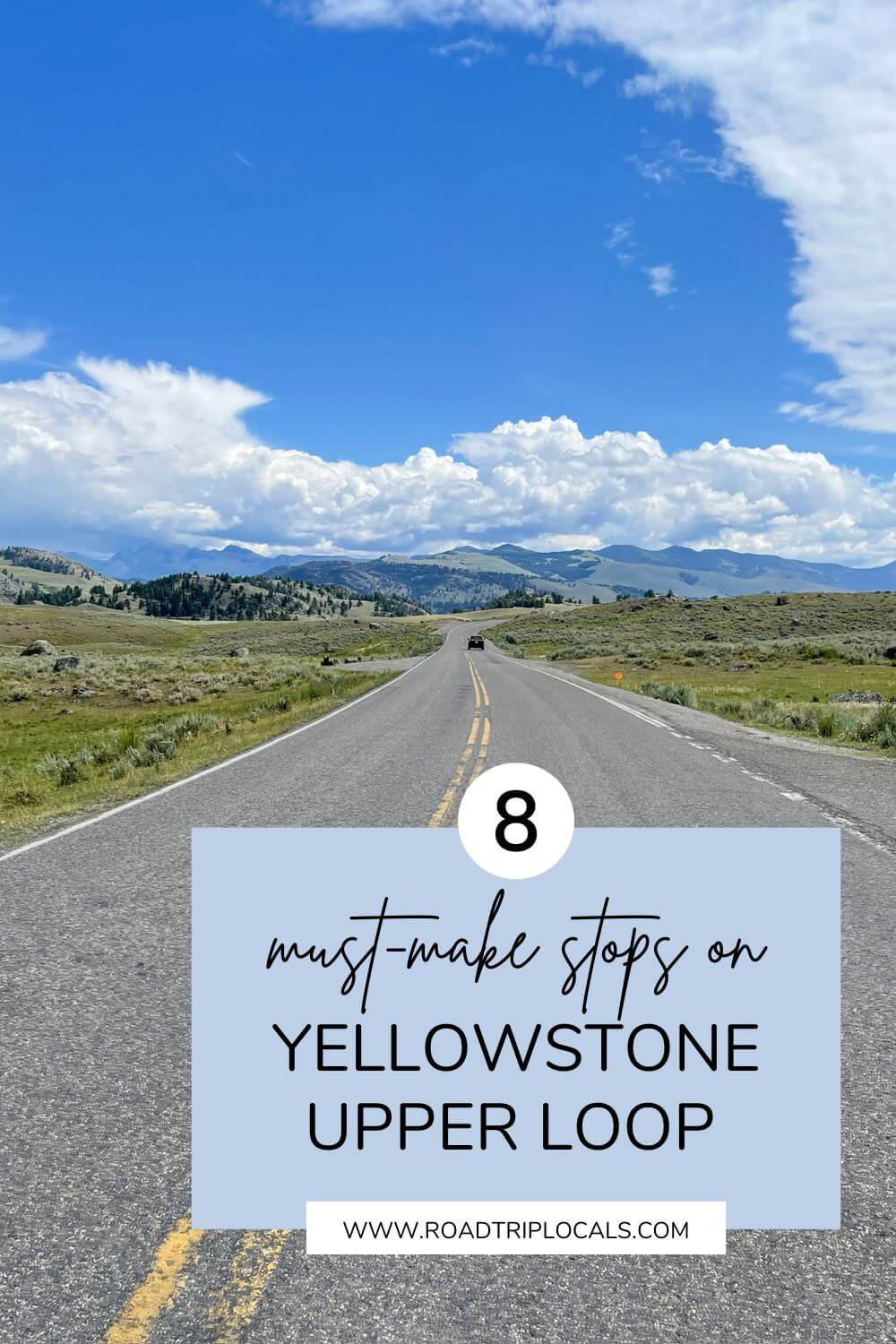Yellowstone Upper Loop: Best Stops for Views, Wildlife, and Hiking
Driving Yellowstone’s Upper Loop is one of the best ways to experience the north side of Yellowstone National Park and is a great way to see many of its most popular landmarks, such as the Mammoth Hot Springs, Mount Washburn, and Tower Fall. Plus, with a short detour from the Upper Loop, you can drive through Lamar Valley, which is arguably the best place in Yellowstone for wildlife watching!
Here’s everything you need to know about Yellowstone’s Upper Loop, including can’t-miss stops, hikes, and wildlife watching hot spots along the way.
Table of Contents Show
P.S. Want all our best Yellowstone tips in one place? Check out our All-Seasons Yellowstone Travel Guide. It’s packed with maps, itineraries, and everything you need to explore Yellowstone in every season!
What is the Yellowstone Upper Loop?
Yellowstone’s Upper Loop is the northern half of the park’s main driving route. It connects four key areas: Mammoth Hot Springs, Norris Geyser Basin, Canyon Village, and Tower-Roosevelt. The Upper Loop is about 68 miles long and takes approximately 2 hours and 15 minutes to drive without stops, but you’ll definitely want to stop.
Along the way, you’ll pass geothermal features, canyon overlooks, and incredible wildlife habitats, including the Mammoth Hot Springs terraces, Norris Geyser Basin, Mount Washburn, and Tower Fall.
Some of the best wildlife viewing in the park also happens along the Upper Loop, especially if you add the detour into Lamar Valley. To see and enjoy it all, give yourself at least half a day, or better yet, a full day to explore.
The Grand Loop
The full driving route through Yellowstone is called the Grand Loop and is divided into two main sections: the Upper Loop (north) and the Lower Loop (south). The Upper Loop features dramatic landscapes, scenic mountains views, and Yellowstone’s top wildlife-watching destinations. The Lower Loop, meanwhile, delivers Yellowstone’s greatest geothermal hits and scenic lake (and canyon) views. Both are worth doing.
Yellowstone Upper Loop refers to the northern loop of Yellowstone’s Grand Loop Road.
1-Day Itinerary and Map of Yellowstone’s Upper Loop
Yellowstone’s Upper Loop is your gateway to mountain views, incredible wildlife, and some of the park’s most dramatic landscapes. Here’s how we recommend spending one full day on the Upper Loop:
Start your day with sunrise in Lamar Valley: Kick off your Northern Yellowstone adventure with a detour to Lamar Valley, one of the best places in North America for wildlife watching, especially at sunrise. The early morning light, quiet roads, and cool temperatures make it an ideal time to spot wolves, bears, bison, elk, foxes, and more. Drive slowly, scan the hillsides and riverbanks, and don’t rush. This is one of the most magical parts of Yellowstone, and it’s worth taking your time.
Stop at Tower-Roosevelt and Tower Fall: On your way back from Lamar, stop at the Tower Fall overlook for a view of the 132-foot waterfall plunging into the canyon below. In the spring, this area is known for bear activity, so keep your eyes peeled. Restrooms and a large parking area make this a good snack or bathroom break.
Drive Dunraven Pass to Mount Washburn: Continue south through Dunraven Pass, one of the most scenic stretches in the park. If you have time and energy, hike part of the Mount Washburn Trail for panoramic views of Yellowstone. Even if you don’t hike, the detour along Chittenden Road offers stunning overlooks and wildlife viewing opportunities.
Explore the Grand Canyon of the Yellowstone: Next stop: Canyon Village, where you’ll find one of the most iconic sights in the park—Artist Point. From here, you can see the Lower Falls dropping into the colorful canyon below. If you want an up-close view, consider the Brink of the Lower Falls Trail or Lookout/Red Rock Point on the nearby North Rim Drive.
Visit Norris Geyser Basin: After exploring the Grand Canyon of the Yellowstone, head west to Norris Geyser Basin, one of the park’s most active and dramatic thermal areas. Walk the Porcelain Basin boardwalk for bubbling pools, steaming vents, and a landscape that feels like another planet. If you have time, take the trail through the Back Basin to see features like Steamboat Geyser, the tallest active geyser in the world.
End your day at Mammoth Hot Springs: There’s no better way to close out your Upper Loop adventure than with golden hour at Mammoth. Walk the boardwalks through the Upper Terraces, where steam rises and colors glow in the setting sun. Then drive (or contine walking) to the Lower Terraces for more expansive views and a peaceful end to your Yellowstone day. Sunset here is truly something special.
Optional Add-On: Bunsen Peak (if time allows): If you’re heading back toward Mammoth and still have daylight, hike Bunsen Peak for sweeping views.
A few final tips:
Wildlife is most active at dawn and dusk, especially in Lamar and Tower-Roosevelt.
Roads through Dunraven Pass can be steep and winding, so go slow and enjoy the views.
Start early and pack snacks, especially if you’ll be out wildlife watching for hours.
If you see cars pulled over, it likely means wildlife is nearby. Stay in your car and use pullouts to safely spot and observe.
When’s the Best Time to Drive Yellowstone’s Upper Loop?
We’ve driven the Upper Loop in every season, and our top pick is late May to early June. Wildlife is incredibly active, the roads are mostly if not entirely open, and the crowds haven’t yet hit full summer levels. But the truth is, each season has something special to offer.
Here’s what to expect, season by season:
Winter (Late Nov–March): Magical and quiet, but limited access
Winter is a gorgeous time of year to drive through Yellowstone. However, it’s also the most limited time of year to drive through the park. This is because most roads in Yellowstone National Park are closed to personal vehicles during winter months. The only part of the Upper Loop you can drive in the winter is from Gardiner (North Entrance) to Mammoth Hot Springs, to Tower-Roosevelt, and out to Lamar Valley and Cooke City (Northeast Entrance).
That stretch includes some of the best wildlife watching in the park, especially wolf watching! If you’re up for snowshoeing, skiing, or want the park practically to yourself, this is a magical time to visit. Just know that Norris, Canyon, and Tower Fall are not accessible by car in winter.
Driving the Upper Loop in the winter
Spring (April–June): Baby animals, bears, and gradually opening roads
In early spring, road access is limited similar to winter months. The portion of the Upper Loop between Mammoth and Norris, as well as Norris to Canyon, usually open in late April. The full Upper Loop is typically open by late May.
Spring is one of the best times of year for wildlife and you might spot bison calves, bear cubs, elk calves, and even wolf pups! The weather is still cool, and snow may linger at higher elevations, but the wildlife activity more than makes up for it. Mid-May to early June is a favorite time for many repeat visitors.
Mammoth to Tower-Roosevelt is open year-round. Mammoth to Norris, and Norris to Canyon, generally opens in late April. The entire Upper Loop is generally open by the end of May. The section between Tower Fall and Canyon is the last to open.
Summer (July–September): Everything’s open, but it’s busy
Summer is the most popular time to drive the Upper Loop. All roads are open, the days are long, and the weather is typically warm and dry. You’ll be able to visit every major stop, including Mammoth, Norris, Canyon Village, Tower-Roosevelt, and detour to Lamar Valley.
The trade-off? More traffic, full parking lots, and crowds at major overlooks. Plan to start early, stay out late, and be flexible with your schedule. Dawn and dusk are the best times to see wildlife and avoid the biggest crowds.
Bonus: The nearby Beartooth Highway, accessible from Cooke City, is typically open Memorial Day through mid-September and is one of the most scenic drives in the country!
Bison Jam in Lamar Valley
Fall (Late Sept–Oct): Fewer crowds, cooler temps, and the elk rut
Fall is a fantastic time to drive the Upper Loop, especially for photographers and wildlife watchers. The roads usually stay open until late October, and the crowds begin to thin out.
This is peak season for the elk rut around Mammoth Hot Springs and you might hear bull elk bugling or see them gathering in town. Fall also brings cooler weather, occasional snow at higher elevations, and beautiful golden tones throughout the valleys.
Bull elk on the side of Yellowstone Upper Loop near Mammoth Hot Springs.
Is it better to drive the Upper Loop clockwise or counter-clockwise?
There’s no bad place to start driving Yellowstone’s Upper Loop and no wrong direction to drive. All have their benefits, so pick whichever starting location is closest to you and drive in whichever direction gets you where you most want to be when you most want to be there.
If you’re interested in wildlife and planning to detour to Lamar Valley (a must-do!), consider driving clockwise if you’re coming from Mammoth or Gardiner and counter-clockwise if you’re coming from Canyon Village. This will get you to Lamar Valley earlier in the morning, which is best for wildlife. (Reverse this if you want to end your day in Lamar Valley. Dawn and dusk are best for wildlife watching.)
Artist Point in Canyon Village is one of the most popular places in all of Yellowstone National Park (and my favorite viewpoint in the park), so it’s helpful to get here earlier (before 10am) or later (after 4pm) when possible.
In our opinion, it matters less when you get to Mammoth Hot Springs or Norris Geyser Basin, so plan these for the middle of your day. Yes, you may need to work for a parking space, but the views are similar here at any time of day.
My pick would be to drive clockwise from Mammoth starting as early in the morning as possible. (Be in Lamar or Tower-Roosevelt by sunrise.) This way, you optimize wildlife watching from Mammoth to Lamar, Tower-Roosevelt, and Dunraven Pass and can get to Artist Point by mid-to-late-morning, hopefully still beating peak crowds. Plus, ending your day walking the Mammoth Hot Springs terraces at sunset is gorgeous!
8 Best Stops Along Yellowstone Upper Loop
Here are eight of the best overlooks, hikes, and places to stop along the Yellowstone Upper Loop! We’re sharing these as though you’re driving clockwise from Gardiner, so it’s easier to follow along.
*We designate our favorite stops with asterisks.
1. Roosevelt Arch (bonus stop if you're staying in Gardiner)
Okay, this one’s technically just outside the Upper Loop, but if you're staying in Gardiner, you’ll drive right past it, and it's definitely worth a stop.
The Roosevelt Arch is a historic stone gateway built in 1903 to mark the North Entrance of Yellowstone, making it one of the most iconic landmarks in the park. It was named after President Theodore Roosevelt, who laid its cornerstone during a visit that same year.
More than just a photo op, the arch symbolizes Yellowstone’s role as America’s first national park and represents the mission to protect wild places for future generations. If you’re starting your day in Gardiner, this is the perfect spot to kick things off.
2. Mammoth Hot Springs*
Mammoth Hot Springs is one of the most popular and most unique stops on the Upper Loop. Its surreal landscape of steaming terraces was formed over thousands of years as mineral-rich water deposited layers of travertine, creating formations that constantly shift and change.
The area is divided into Upper and Lower Terraces, each with its own distinct look:
The Upper Terraces are broad and dramatic, with bright white, orange, and rust-colored formations that resemble cascading rock waterfalls.
The Lower Terraces are more delicate, with smaller features and colorful pools nestled among patches of greenery.
Well-maintained boardwalks wind through both sections, offering close-up views of the terraces and a chance to see Yellowstone’s geothermal activity in a totally different form than the park’s geyser basins. This area is especially beautiful during golden hour (the hour before sunset).
3. Lamar Valley*
Lamar Valley stretches across Yellowstone’s northeast corner, where wide-open grasslands, meandering rivers, and rolling hills create the perfect habitat for animals to roam. Though it’s technically a detour off the Upper Loop, Lamar Valley is an absolute must. This is Jonathan’s favorite spot in all of Yellowstone, and for good reason—it’s hands down the best place in the park for wildlife watching.
This area is home to:
Bison (often in huge numbers)
Elk and pronghorn
Grizzly and black bears
Coyotes and red foxes
And, if you’re lucky, one of the park’s resident wolf packs!
Lamar’s open terrain makes spotting wildlife easier than anywhere else in the park, and it's worth visiting in any season, from wolf-tracking in winter to baby animals in spring to rutting elk in fall.
👉 RTL Tip: Bring binoculars or a spotting scope, and take your time. Wildlife often appears when you slow down, and when you least expect it.
Grizzly bear grazing in Lamar Valley
4. Cooke City
Tucked into the Absaroka Mountains, just outside Yellowstone’s Northeast Entrance, Cooke City is a tiny town with a big sense of character. Once a booming mining hub, it still holds onto its historic charm, with rustic wooden buildings, a slower pace, and a laid-back, mountain-town vibe.
Today, Cooke City serves as a gateway to adventure. It’s a popular stop for those exploring Lamar Valley, as well as hikers, wildlife watchers, and road trippers heading into the nearby Beartooth Mountains or Shoshone National Forest.
If you’ve made the detour into Lamar Valley, it’s worth continuing just a bit farther to grab a coffee or sandwich at Cooke City Coffee, browse a local shop, or just take in the scenery before turning around. Or, if you’re up for one of the most scenic drives in the country, keep going and hop on the Beartooth Highway, a jaw-dropping mountain road that climbs above 10,000 feet and offers unforgettable views.
5. Tower-Roosevelt*
Tower-Roosevelt is another must-stop, especially from mid-May to early June, when the area becomes one of the best spots in the park for bear sightings. This stretch of road between Tower Junction and Tower Fall is a favorite for spotting black bears (often with cubs) as they forage and explore the hillsides near the road.
The other major highlight here is Tower Fall, a stunning 132-foot waterfall that tumbles over volcanic rock into the Yellowstone River below. A short walk from the Tower Fall parking area brings you to several overlooks with excellent views of the falls and canyon.
Mama bear and two cubs in a tree by Tower Fall
6. Dunraven Pass to Mount Washburn
The road from Tower Fall to Canyon Village follows the Yellowstone River and skirts the edge of the Grand Canyon of the Yellowstone. It climbs through the Washburn Range and over Dunraven Pass, making it one of the most scenic stretches of road in the park.
Along this stretch, you’ll find Chittenden Road, a short detour that leads to a trailhead for Mount Washburn. This popular hike takes you to one of Yellowstone’s most prominent peaks, with sweeping views of the Absaroka and Gallatin mountain ranges, the Yellowstone Caldera, and even the Teton Range on clear days.
The area is also rich in wildlife. Keep an eye out for bighorn sheep, mountain goats, bears, and birds of prey. It’s one of the best places in the park for birdwatching.
7. Artist Point in the Grand Canyon of the Yellowstone*
Artist Point is one of the most iconic overlooks in Yellowstone (and a personal favorite!). From this viewpoint on the south rim of the canyon, you’ll see the powerful Lower Falls plunging over 300 feet into the colorful canyon below.
While Artist Point is technically on Yellowstone’s Lower Loop, it’s located just past Canyon Village, making it an easy and worthwhile stop during your Upper Loop drive. If you’re already at Canyon, don’t skip it. The view is one of the most breathtaking in the park.
Grand Canyon of the Yellowstone, near Brink of the Lower Falls
Artist Point Overlook in the spring
8. Norris Geyser Basin
Norris Geyser Basin is one of the hottest and most active thermal areas in Yellowstone, known for its steaming vents, colorful hot springs, and unpredictable geysers.
The basin is divided into two main sections: the Back Basin and the Porcelain Basin. The Back Basin features a forested trail with scattered thermal features, including Steamboat Geyser, the tallest active geyser in the world. While it erupts irregularly, even seeing it steaming is a highlight.
The Porcelain Basin has a more open, lunar-like landscape with white mineral deposits, boiling pools, and roaring fumaroles. Boardwalks loop through both areas and allow you to get an up-close look at this constantly changing geothermal environment.
5 Spots for Wildlife Watching Along the Upper Loop
The Upper Loop offers some of the best wildlife viewing in Yellowstone. Here are five places where sightings are common, along with the best seasons to visit each:
1. Elk and Pronghorn between Gardiner and Mammoth (year-round)
As you drive from Gardiner to Mammoth, keep an eye out for pronghorn grazing in the sagebrush. Known as the fastest land mammals in North America, they’re often seen in the open grasslands just outside the park. Elk are also commonly spotted near Mammoth throughout the year.
2. Elk Rut at Mammoth Hot Springs (fall)
In September and October, Mammoth Hot Springs becomes a stage for the elk rut. Bull elk gather to compete for mates, and their bugling echoes across the terraces. It’s one of the most dramatic wildlife displays in the park. Drive between Mammoth and Tower-Roosevelt and watch for elk along the roadside.
3. Bears & Moose near Tower Fall (spring)
From mid-May through June, the stretch between Tower-Roosevelt and Tower Fall is one of the best areas in the park to see black bears with cubs. Moose are also occasionally seen. If you see a group of cars pulled over, chances are good there’s something exciting nearby!
Moose along the Yellowstone Upper Loop driving to Tower Fall in May
4. Bears, Wolves, Bison, and More in Lamar Valley (year-round)
Lamar Valley is Yellowstone’s top destination for wildlife viewing in every season.
In winter, wolf packs are easier to spot against the snow.
In spring, bears and cubs emerge from hibernation.
In summer, bison gather in large herds during the bison rut.
You might also see coyotes, foxes, and bighorn sheep on the rocky slopes.
5. Bighorn Sheep and Birds of Prey at Dunraven Pass (summer and fall)
The scenic drive between Tower and Canyon climbs over Dunraven Pass, where open slopes make it a great place to spot bighorn sheep and raptors like hawks and eagles. Pull over at turnouts along the way and scan the rocky cliffs for movement. This is one of the best areas in the park for birdwatching and often a quieter place to enjoy wildlife.
5 Scenic Hikes Along Yellowstone’s Upper Loop
From easy boardwalk strolls to high-elevation summit trails, here are five of the best hikes to explore along the Upper Loop:
1. Mammoth Hot Spring Terraces
The boardwalks at Mammoth Hot Springs let you walk through one of Yellowstone’s most surreal landscapes. The Lower Terraces feature colorful springs like Liberty Cap, Jupiter Terrace, and Palette Spring, known for its bright orange, yellow, and green mineral streaks. The Upper Terraces take you higher into the formation, with close-up views of springs like Dryad, Canary, and Cupid.
2. Dunraven Pass to Mount Washburn
This challenging 6.8-mile out-and-back hike starts at Dunraven Pass and climbs to the summit of Mount Washburn, one of Yellowstone’s most prominent peaks. At the top, you’ll be rewarded with sweeping views of the Lamar Valley, the Yellowstone River, distant mountains, and even the Tetons on a clear day.
View from the start of the trailhead at the top of Chittenden Drive
3. Brink of the Lower Falls
Located near Canyon Village, this short but steep trail leads down a series of switchbacks to a jaw-dropping view at the very edge of Lower Falls. The sound of rushing water, the rising mist, and the intimate view into the Grand Canyon of the Yellowstone make this one of the most memorable stops near the Upper Loop.
4. Norris Geyser Basin Boardwalk
This hike is more of a choose-your-own-adventure stroll through Yellowstone’s most active thermal area. The Porcelain Basin offers a wide-open landscape of steam vents and bubbling pools, while the Back Basin leads through forested paths with features like Emerald Spring, Opal Pool, and Steamboat Geyser, the tallest active geyser in the world. The boardwalks make it easy to explore, and the variety of geysers and colorful thermal features make it one of the most complete stops along the Upper Loop.
5. Bunsen Peak
Located just south of Mammoth Hot Springs, Bunsen Peak is a moderately challenging 4.4-mile out-and-back trail with some of the best panoramic views on the north side of the park. The trail climbs steadily through forest and open hillside before reaching the summit, where you’ll get sweeping views of the Gallatin Range, the Yellowstone River valley, and the distant Absaroka Mountains. It’s a great hike for spotting wildflowers in summer and the combination of rewarding views, manageable distance, and proximity to Mammoth makes Bunsen Peak a favorite among Upper Loop hikers.
❓FAQ: Driving Yellowstone’s Upper Loop
Q: Can you drive through the North Entrance of Yellowstone?
Yes! You can absolutely drive through Yellowstone’s North Entrance. In fact, the North Entrance in Gardiner, Montana, is the only entrance open year-round. From Gardiner, you’ll drive into the park and head toward Mammoth Hot Springs, which is the official start of the Upper Loop. This short stretch from Gardiner to Mammoth is a scenic drive on its own and a great way to begin your day. If you’re staying in Gardiner, it’s also the only way to access the Upper Loop.
Q: Where does the Upper Loop start and end?
The Upper Loop doesn’t have a set starting or ending point. You can hop on from several places around the park, depending on where you’re staying or entering from.
If you’re staying in Gardiner (North Entrance): Start at Mammoth Hot Springs, then head clockwise to Tower-Roosevelt or counterclockwise to Norris Geyser Basin.
If you’re coming from West Yellowstone: Your closest entry point is Norris Geyser Basin. From there, you can drive clockwise to Mammoth or counterclockwise to Canyon Village.
If you’re coming from Cody, Lake Village, or the South Entrance (Grand Teton): Start at Canyon Village, right near the Grand Canyon of the Yellowstone.
If you’re coming from the Northeast Entrance (Cooke City): Start at Tower-Roosevelt, then loop in either direction.
No matter where you begin, the loop connects Mammoth, Norris, Canyon Village, and Tower-Roosevelt, so you’ll end up right back where you started.
Q: Should I stay in West Yellowstone or Gardiner to drive the Upper Loop?
Both West Yellowstone and Gardiner are popular home bases just outside the park, but they offer very different access points.
West Yellowstone is closer to the Lower Loop, with easier access to geyser country, like Old Faithful, Grand Prismatic Spring, and Midway Geyser Basin.
Gardiner, located at the North Entrance, is closer to Mammoth Hot Springs and Lamar Valley, which makes it ideal for wildlife watching and driving the Upper Loop.
Both towns are about the same distance from Canyon Village, which sits at the intersection of the Upper and Lower Loops near Artist Point and the Grand Canyon of the Yellowstone.
If wildlife viewing is a priority, we highly recommend staying in Gardiner or Mammoth Hot Springs. If geysers and hot springs are at the top of your list, West Yellowstone or the Old Faithful area may be a better fit. For a central location with easy access to both loops, Canyon Village is a great option.
👉 Our personal pick? We love the scenery and wildlife on the north side of the park, so we prefer Gardiner. If we’re staying in the park, we love the central location of Canyon Village.
Q: How long is the Upper Loop drive?
The loop itself is about 68 miles long and takes roughly 2.5 hours to drive without stops, but you’ll want to stop… a lot! Plan for a full day to make the most of it.
Q: What are the best stops along the Upper Loop?
Some of the highlights include:
Mammoth Hot Springs Terraces
Norris Geyser Basin
Canyon Village (and nearby Artist Point)
Tower Fall
Mount Washburn
Lamar Valley (detour)
Cooke City (if you keep going past Lamar)
Q: Is Lamar Valley part of the Upper Loop?
Not technically. Lamar Valley is an out-and-back detour from Tower-Roosevelt Junction. But yes, you should absolutely do it. It’s the best place in the park to see wildlife like wolves, bears, bison, and elk.
Q: Is it really worth driving the Upper Loop?
Yes! The Upper Loop is known for:
Some of the best wildlife viewing in the park
Dramatic scenery, from the Grand Canyon of the Yellowstone to Mount Washburn, and along Yellowstone’s Northern Range
Mammoth Hot Springs
Fewer crowds than the Lower Loop (depending on the time of year)
Q: What direction should I drive the Upper Loop?
Either direction works! That said, we recommend:
Driving clockwise from Mammoth or Gardiner so you reach Lamar Valley and Tower-Roosevelt early, and end your day with sunset at Mammoth or Norris.
Q: What’s the best time of year to drive the Upper Loop?
We love it in late May to early June for wildlife sightings and smaller crowds. But every season has perks:
Spring: Baby animals and active bears.
Summer: All roads are open, best weather.
Fall: Elk rut, changing colors, thinner crowds.
Winter: Only parts are open (Gardiner to Lamar), but it’s peaceful and magical. Perfect for wolf watching.
Q: Can I drive the Upper Loop in winter?
Partially. In winter, only the road from Gardiner to Mammoth, Tower-Roosevelt, Lamar Valley, and Cooke City stays open. Roads to Norris, Canyon, and Tower Fall are closed to vehicles until spring.
Q: Are there non-boardwalk hikes on the Upper Loop?
Yes! Some favorites include:
Dunraven Pass to Mount Washburn (panoramic views)
Brink of the Lower Falls (feel the waterfall’s power)
Bunsen Peak (overlook valleys and thermal areas)
Q: What wildlife can I see along the Upper Loop?
Lamar Valley: Wolves, bears, bison, coyotes, elk, foxes, bighorn sheep.
Tower-Roosevelt: Bears and moose in spring.
Gardiner to Mammoth: Elk and pronghorn year-round.
Mammoth Hot Springs: Elk during the fall rut (listen for bugling!).
Q: Is the Upper Loop dog-friendly?
Dogs are allowed at parking areas, overlooks, and roads, but not on any park trails. So, yes… but where dogs can go is limited!
Q: What’s the speed limit on the Upper Loop?
The park speed limit is 45 mph max, often slower. Wildlife (especially bison!) have the right of way. Always pull over completely to take photos or let others pass.
Q: How do I check road closures or construction?
Before you go, always check for updated conditions on the Yellowstone website or the NPS app. Delays and closures happen often.
The Upper Loop, taken near Petrified Tree
Keep Planning Your Trip to Yellowstone National Park
Want to make the most of your Yellowstone adventure without the overwhelm? Our All-Seasons Yellowstone Travel Guide has you covered! It’s packed with insider tips, easy-to-follow maps, and ready-to-go seasonal itineraries (no guesswork required). We’ve spent 9 years and 10+ trips exploring every corner of the park, and this guide brings it all together: the highlights, the hidden gems, and our top Yellowstone recommendations.
👉 Grab the All-Seasons Yellowstone Travel Guide here.
Save this for later
Hover over either image below and click on the red “Save” button that pops up in the upper lefthand corner of the image to save this on Pinterest for later. (If you’re on mobile, you might have to tap the image first to see the red ‘Save’ button.)
Happy Travels!
